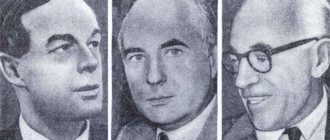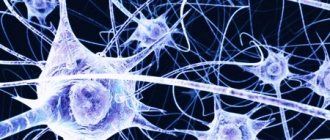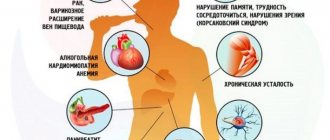I remember this famous expression that “nerve cells do not recover” from my student days. However, life and eternal stress were familiar to me from early childhood. There were worries and emotional turmoil all the time. And even now, my colleague always says: “Will there ever be a time of peace in your “kingdom?” It’s probably better not to wait for him! In the meantime, nerve cells die from restlessness and eternal stress, but you can build new neural connections in the brain... this is what the article is about!
What is a neuron, its structure
In the journal “Science and Life” No. 9 for 2021. An interesting article was published about the myth about the dying of nerve cells by Doctor of Medical Sciences V. Grinevich. And a refutation of this fact was given.
But let's first look at the structure of a neuron, a unit of a nerve cell.
Neuron structure
A nerve cell is a body with a nucleus, one long axon and branched short dendritic roots. Neurons transmit nerve impulses from one to another. There are a lot of neurons in the brain, approximately 100 billion.
Neurons differ from each other in size, dendrite branching, and axon length.
I really liked the expression in the article about the plasticity of nerve cells. But this is rather not plasticity, but the fact that the dendrite has such a property as “branching”, and thus with the help of this there is an increase or, as psychologists often say, “the construction of new neural connections in the brain.”
There is also another way to build new neural connections in the brain, this method was discovered by the science of neurobiology. Scientific evidence shows that nerve cells are regenerated using replacement systems, such as other neuronal stem cells, and even blood stem cells may be involved in this process.
This process is called neurogenesis. This is the future! Only scientists do all this with the help of complex operations and medications.
What is within our control, what can we do ourselves if it is necessary for new neural connections of the brain to appear in our body?
Rearranging neural pathways
"Happiness Hormones"
Each person is born with many neurons, but very few connections between them. These connections are built as we interact with the world around us and ultimately make us who we are. But sometimes you have a desire to slightly modify these formed connections. It would seem that this should be easy, because we developed them without much effort on our part in our youth. However, the formation of new neural pathways in adulthood is unexpectedly difficult. Old connections are so effective that giving them up makes you feel like your survival is at risk. Any new nerve chains are very fragile compared to the old ones. When you can understand how difficult it is to create new neural pathways in the human brain, you will be more pleased with your persistence in this direction than berate yourself for the slow progress in their formation.
A world-class experiment proves this fact
The emergence of new neural connections in the brain is proven by the experiment of Canadian professor G. Huether. In his speech at the World Congress of Psychiatrists, he spoke about his experiment.
We invite you to the free webinar “The Brain is a Superpower We Don’t Use.” You will learn everything about the capabilities of the brain, how to develop memory and attention, get rid of the chaos in your head and make a quantum leap in your own life during a difficult period.
Many novices of the monastery in Canada lived to be 100 years old in complete health, both mentally and mentally. During a medical examination, no degenerative changes characteristic of old age were found in their brains. Professor G. Hünter suggested that only 7 factors are needed to maintain brain plasticity and the emergence of new neural connections in the brain.
7 factors for building new neural connections in the brain
- Friendly attitude with loved ones, careful attitude towards “family ties”.
- It is necessary to have good communication skills, to be able to “get around your own and other people’s sharp corners” that we and everyone have.
- It is necessary to have a stable worldview, and not “throw from one extreme to another”; I consider this to be a “conscious attitude towards life”. When you don’t shift your mistakes onto other people, but take responsibility for them.
- The ability to accept reality as it is. Probably many people wanted to fly into space or become great ballerinas. But reality now shows that this did not work out for many reasons. This means that this reality should be calmly accepted. And don’t reproach yourself every time that “if only I had money, a husband, or, for example, an inheritance, then I would have done everything differently”... that’s what it’s all about!
- You need to learn something new all your life, and also apply this knowledge in life. It is clear that you are unlikely to study ballet at the age of 60, but you can simply learn to move well in dance to music. Your health and spatial orientation will also improve. It’s worth finding that activity that for some reason you’ve been putting off all your life. For example, cook something interesting or bake bread. This will not only bring you fulfillment in life, but you can become in demand and benefit others.
- A balanced diet will significantly improve your well-being and prevent you from gaining excess weight. Review your diet, eat small portions and count calories. And to maintain health, it is worth taking periodically healthy dietary supplements with minerals and vitamins. They will improve your well-being and your vital activity.
- Get rid of stress from life, or don’t “take it to heart” any stressful situations. The expression that “all diseases come from nerves” has roots there. And nerve cells die from prolonged stress.
A book about neural connections of the brain from the famous neuroscientist Wendy Suzuki to help
I liked the advice in this book that you need to look for physical activity “to your liking.” Running, walking with friends or alone in a park or along the seashore doesn’t matter, the main thing is to have physical activity.
The author's method of aerobic exercise from Wendy Suzuki can change your life and way of thinking. I recommend reading her book “The Strange Girl Who Fell in Love with the Brain.”
Only you can make your life happier. Physical activity for at least 10 minutes a day, and preferably at least 30 minutes, every day, will give you a great boost of energy and positivity.
Wendy Suzuki studied with her students during classroom classes, and then through this research she proved that the release of neurotransmitters (pleasure hormones) enhances the brain's abilities and is involved in building new neural connections in the brain.
INTRODUCTION TO COGNITIVE NEUROSCIENCE. Chapter 3. Neurons and connections between them.
INTRODUCTION TO COGNITIVE NEUROSCIENCE. From the textbook BRAIN. COGNITION. INTELLIGENCE. E-book https://t.me/kudaidem/1879
Chapter 3. Neurons and connections between them.
What do we know about the processes occurring at the neuronal level? Can we now construct a consistent theory regarding events at this level?
The main cells of the brain are neurons, highly conserved from an evolutionary point of view . They have persisted relatively unchanged for many hundreds of millions of years, and even very different animal species have the same types of neurons . From many points of view, neurons are no different from other cells, but there is one thing that sets them apart from the rest: a specialization in electrochemical signaling, thanks to which they are able to receive an incoming signal at the dendrites and send an electrochemical signal along the axon. The entire brain can be considered as a highly complex structure consisting of interconnected neurons.
(Fig. 3.1).
Dendrites and axons are extensions of the neuron body; one neuron can have up to ten thousand dendrites and one axon.
(Fig. 3.2 and 3.3).
The action potential (AP) travels along the axon much more slowly than the electric current in a computer, but our brain performs many tasks much better than modern computers. Currently, computers are far behind humans in tasks of perception, language communication, semantic memory, motor control and creativity.
Neuroscience focuses on the connections and interactions of neurons. It is convenient to start considering such connections with a generalized neuron .
Classic neurons connect via synapses, which can be excitatory or inhibitory.
(Fig. 3.6)
Neuron activity is mediated by dozens of factors—the sleep-wake cycle, the availability of neurotransmitter precursors, and many others. All of these factors influence the probability of a signal passing between two neurons and can be represented as synaptic weights. Thus, the entire diversity of neurons can be successfully represented in the form of an integrative neuron, and all methods of interneuron communication can be successfully represented in the form of the probability of signal transmission between neurons.
There are at least six major neurotransmitters and at least thirty "less important" ones, mostly neuropeptides .
Even the dendrites of a single cell appear to be capable of information processing . There is also evidence that neuroglia , the supporting tissue of the nervous system, can also take part in information processing.
It is now known that stem cells exist in some parts of the adult brain. The formation of new synapses occurs throughout life; To form new synapses, dendritic processes can form within a few minutes.
(Fig. 3.7).
1.3. Information processing by neurons.
Artificial neural networks have been used to model many brain functions—recognizing image elements, controlling robots, learning, and improving functioning based on experience.
In many cases, such networks performed tasks better than computer programs based on logic and mathematics.
They also help us understand the principles of operation of real neural networks in the brain.
Neural networks help us understand the functioning of the nervous system.
Thus, artificial neural networks can serve as models for studying real structures in the brain.
We will limit ourselves to considering synapses of only two types - excitatory (increasing the probability of the passage of AP (Action Potential) on the postsynaptic neuron) and inhibitory (reducing this probability).
Glutamate, the most common neurotransmitter in the central nervous system, is an excitatory.
GABA (gamma aminobutyric acid) is the most common inhibitory neurotransmitter .
Arrays of neurons, often referred to as maps, are common throughout the nervous system.
2.1. Simplified case: receptors, pathways and circuits.
Each sensory nerve may contain several parallel channels, each carrying slightly different information. Thus, the visual tract has a channel for transmitting color, called small-cell, and a channel for transmitting the shape and size of an object, called large-cell.
In the same way, somatosensory pathways combine channels for transmitting touch, pressure, pain and some others.
Most sensory fibers terminate in the thalamus, where they transmit signals to neurons that terminate in the cortex.
(Fig. 3.10 and 3.11)
Thus, in most signaling pathways there are feedback loops, such as in a neural network with two or more layers.
From this point of view, the brain appears to be a system of arrays and networks influencing each other .
A neuron array is a two-dimensional network of neurons .
When arrays correspond to the spatial organization of a particular structure, they are called maps.
Both temporal and spatial coding take place in the brain, along with many other ways of encoding and processing information.
Spatial maps are the most visual form of spatial coding.
(Fig. 3.15 and 3.16).
Somatosensory information
such as touch and pain is also processed by cortical maps. Other senses, such as hearing, taste, and smell, are much less associated with receptor location, but the auditory cortex has a map-like wedge-shaped region.
Thus, even information from sense organs not associated with space is processed by arrays and maps of neurons.
Our brain organizes huge amounts of incoming information to reflect the position of surrounding objects. The motor cortex, as you might guess, also looks like a disproportionate map of the body's skeletal muscles.
The main question regarding sensory technology today is how high-level processing of perceived information occurs. And the neural network model provides one possible answer.
The brain continually adjusts motor systems based on sensory information and adapts sensory systems through motor activity.
Sensory systems can be thought of as hierarchical systems, consisting of lower-order hierarchical systems, starting with receptors and gradually moving to increasingly complex objects.
Motor systems can be represented as a hierarchical structure of the opposite direction, ending in motoneurons .
There is a continuous exchange of information between the two systems in a cycle from perception to action, from the lowest to the highest levels of planning, thinking and analysis of possible developments.
(Fig. 3.20 Hierarchical system from the field of architecture).
In the diagram of a hierarchical information processing system, each array of neurons is called a map; cards exist at different levels, and the signal can go up, down, and to another card at the same level.
When considering the electrical activity of tens of billions of neurons, the brain inevitably begins to seem like a huge orchestra, rather than a single instrument. Over hundreds of millions of years of evolution, neurons with a variety of types of temporal and spatial coding have appeared in the brain (block 3.1).
Information paths have many choice points from which it can be directed along several different paths or transferred to a higher or lower level.
If we return to the step pyramid, then such a branched path is similar to a person’s path to the top: he can reach it in a direct or roundabout way.
The visual picture of the world is subject to constant changes. However, the brain still processes such changes. An animal cannot afford not to notice a predator hiding in the grass just because it is sunset or because a shadow falls on it.
In order to survive, we had to have a superior visual system.
For example, a cat stalking a prey can examine a tree with only one eye, while the other eye remains passive. This leads to the phenomenon of binocular competition —competition between visual inputs from different eyes.
Many animals receive completely different inputs from different eyes - animals such as rabbits and deer have no areas of visual field overlap at all, so for them the phenomenon of binocular competition is impossible.
The brain constantly has some expectations about the external conditions it encounters. When going down the stairs in the dark, we expect that there will be a step under our feet.
When analyzing ambiguously interpreted objects, expectation determines the choice of the most acceptable interpretation option. Many words in a language have more than one meaning, so even as you read this you are forced to deal with ambiguities. The brain relies not only on incoming information - it has many reasons for choosing one option or another , based on predicting the outcome and expectation.
Selective attention allows us to dynamically change our sensory preferences, and long-term memory increases the strength of the synapses responsible for accurate perception.
Many scientists believe that the entire cortex, along with associated areas such as the thalamus, should be considered a single functional unit. It is often called the thalamocortical system .
(Plastic brain).
One of the main properties of animal behavior is the ability to adapt.
The main property of the brain , therefore, is adaptability . However, what changes in the structure of the brain itself lead to such adaptability?
For these purposes, methods for visualizing brain structures, which have received intensive development in the past two decades, are much better suited.
Although most imaging techniques are domain-specific, thereby emphasizing functional separation rather than integration, attempts have been made to study learning as a systemic process involving global changes in brain structure and function.
The development of magnetic resonance imaging technology has made it possible to begin to study changes in the structural components of communication - white matter tracts - under the influence of learning.
Learning to juggle has been shown to cause changes in both the gray and white matter of the brain.
These results were truly revolutionary, since for many years it was believed that the structure of the brain is unchanged .
Such discoveries, which allow us to consider the brain as a functionally and structurally labile organ , are without a doubt a step forward in our understanding of the learning process.
(4.0. Adaptation and training of neuron arrays).
The most well-known rule for training neural networks, expressed in the slogan “ neurons that fire together, wire together.”
Neurons that fire together wire together.
(Hebb Training).
Donald Hebb postulated in 1949 that assemblies of neurons can learn by strengthening connections between neurons that fire simultaneously when stimulated .
The basis of learning and memory is the effectiveness of synaptic connections.
There are many ways to influence the efficiency of synaptic transmission. Thus, two neurons can form more synapses, more neurotransmitter can be produced in the synapses themselves, and the receptors of the postsynaptic neuron can become more effective.
two types of changes involved in learning ; they can be thought of as increased excitation and increased inhibition .
A long-term increase in the excitability of a single neuron is called long-term potentiation .
A long-term decline is long-term depression . Both events take place in the hippocampus.
Visually, Hebbian learning can be represented as thickening of the lines between network nodes, as in a simple collection of cells.
Models with a third, hidden layer allow the neural network to change the strength of connections.
A classic three-layer forward network with a hidden layer and tunable interaction strength can be trained efficiently by mapping the neural network output to the desired output and adjusting the strength of the connections to achieve the desired result.
The process is called backpropagation and is in many ways similar to negative feedback .
Networks of this type are the most common today.
In a self-organizing auto-associative network, the output is matched to the input.
This strategy is useful when recognizing patterns, such as the sound of a familiar voice.
Self-organizing systems are used in nature to solve many problems.
The organisms themselves and their nervous systems can be considered as self-organizing systems.
The self-organizing network is able to cope with the fundamental problem of recognizing human faces.
A person learns to respond to normal, undeformed faces very early in life and soon becomes able to distinguish familiar from unfamiliar faces.
The problem solved by the network is much simpler than that solved by humans, since in the model only the formation of the circuit occurs.
The network is able to learn to predict the location of the mouth at the bottom of the picture and the two eyes at the top.
4.2. Darwinian approach in the nervous system: the cells and synapses best adapted to the task survive.
Neural Darwinism suggests that neurons develop and connect to each other according to Darwinian principles.
Selectionism is an effective way of adaptation.
The selection of neurons leads to the formation of long-lived neural aggregates that perform tasks of adaptation, learning, pattern recognition, and the like.
Neural networks are characterized by a high level of parallelism (which means the ability to perform many different calculations at the same time) and distribution (the ability to process information in different places using different mechanisms).
This indicates the greater proximity of neural networks to biological methods of information processing.
Neural networks are quite easy to translate into mathematical expressions.
Neural networks are capable of processing symbolic information, and symbols can be translated into neural networks.
Neural network learning occurs as the network recognizes the input and cuts off alternative options.
There are many ways to coordinate the work of neurons . One of them is large-scale rhythms , which coordinate the work of large groups of neurons in the same way that a conductor coordinates the playing of a symphony orchestra. If a large mass of neurons is activated simultaneously, then their activity, as a rule, sums up.
Current evidence favors much faster gamma and theta correlations at the frequencies at which the brain does most of this work.
Encephalogram rhythms are now considered to signal different but coordinated processes.
For example, high-density gamma rhythms are thought to be associated with conscious visual perception and the process of solving simple equivalence problems.
Alpha rhythms are traditionally associated with the absence of tasks requiring focused attention, while theta rhythms are currently believed to control the hippocampal region and frontal cortex during long-term memory retrieval. Delta rhythms - signals of deep sleep - group fast neuronal activity in order to consolidate the received data.
When designing an aircraft, engineers build some functional redundancy into its design in case critical systems fail. So, if one engine fails, most of the aircraft will be able to reach the runway on the remaining ones.
Humans and animals also have a certain amount of functional redundancy .
This rule also applies to the brain. The brain is able to work even after receiving very significant damage.
6.0. Conclusion.
Lateral inhibition is a common strategy for highlighting differences between two homogeneous signal regions, such as dark spots on a light background.
Cells in sensory systems have so-called receptive fields that are tuned to certain input parameters, such as line orientation, color, movement, shape and type of object. As the level of visual maps increases, their resolution decreases, while the ability to integrate information increases.
Because sensory and motor systems are studied separately, the brain appears to be a huge sensorimotor organ that allows continuous high-level interactions between input and output.
Spatial arrays of neurons make spatial coding possible, but we should not forget that the nervous system also has temporal coding. The fundamental rhythms of the encephalogram are believed to be responsible for the temporal coordination of the activity of large groups of neurons.
Recent research suggests that the gamma rhythm is responsible for the integration of sensory information into conscious sensations, and the theta rhythm is responsible for retrieving information from long-term memory.
Test assignments for this chapter.
1. Describe the main functions of an integrative neuron.
2. What is lateral inhibition and what role does it play in sensory systems?
3. How can sensory and motor systems be viewed as hierarchical structures?
4. Describe the role of bidirectional interactions in brain function.
5. What is the Darwinian approach to the nervous system and what aspects of brain processes does it address?
6. Name the three most common properties of sensory systems.










